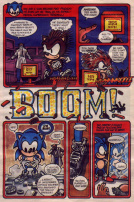Sonic the Comic
From Sonic Retro
Revision as of 16:36, 22 August 2010 by Black Squirrel (talk | contribs)
Sonic the Comic was a UK children's comic published by Fleetway Editions between 1993 and 2002. It was the UK's official SEGA comic and was released every fortnight at 95 pence, later rising to £1.35 before the final issue.
The comic would usually contain four stories, each usually following different storylines and being written and drawn by different writers and artists. In the earlier issues at least one of these stories would be about a different Sega game (see below), the most notable exception being issue #100, where the whole comic told a single story in four chapters.
The comic featured the adventures of Sonic the Hedgehog and his motley crew of freedom fighters as they struggled to liberate the planet Mobius from the control of the evil dictator, Doctor Ivo Robotnik.
Details

Unlike its American counterpart, Sonic the Comic is said to have kept closer to Sega's original westernised ideas for the franchise. StC's game adaptions are often considered to be better than the ones in the Archie series as the writers strived to keep the stories as true to the games as possible. Fans consider the Knuckles' Chaotix and Sonic CD's adaptions, featuring the Brotherhood of Metallix, to be the peak of the comic. Other popular long-running stories included the Super Sonic Saga, The Drakon Empire saga, The Shanazar Saga and the Floating Island saga, which depicted the events of the Mega Drive games Sonic the Hedgehog 3 and Sonic and Knuckles.
However, future adaptions drifted further away from the game's stories, to the point that their Sonic Adventure adaptation was vastly different from the game's storyline, which was mostly caused by SEGA not giving them ANY info on the game- Nigel Kitching has stated the only image they had of Chaos was a small, blurry JPEG of Chaos 0. After this adaption, thanks to Egmont/Fleetway's policies regarding the market and audience, the comic stopped having new stories and went into reprints (as the executives concluded that the audience was refreshed every 5 years.) This caused the comic to lose more and more popularity, until it ended in 2002.
The comic did add some characters of its own, however. Key characters such as Johnny Lightfoot and Porker Lewis were introduced at an early stage and were based off the rabbit and pig animal buddies respectively. Early on the comic introduced Captain Plunder and his Mystic Cave pirates. The genius Tekno the Canary was later introduced, along with Shortfuse the Cybernik, a squirrel named "Shorty" that had been trapped in the shell of an enhanced badnik but had full control over his weaponry. Sonic's team would operate from their secret base in Emerald Hill Zone, protecting the townsfolk from Robotnik. The base was discovered, and so Sonic's freedom fighters had to operate from a makeshift travelling circus headed by Sonic's alter-ego "Bob Beaky". Eventually the Emerald Hill folk were moved to the Floating Island out of harms way, taking residence in Mushroom Hill Zone.
Though the comic started before SatAM, Sonic the Comic took some inspiration from the TV show. For example, Troopers were used instead of SWATBots, which eventually had a renegade general called Brutus, who, after having Robotnik's memories implemented into its brain, fought against both Robotnik and Sonic at the same time. Snively's role was replaced by the pathologically loyal Grimer, who stayed at Robotnik's side until the last issue when Robotnik's insanity had become apparent.
The Chaotix appeared in StC, consisting of Vector the Crocodile, Charmy Bee, Espio the Chameleon, and Mighty the Armadillo. Nack the Weasel started off as a member of the group before betraying them and becoming a reoccuring enemy. Many other sub-plots and storylines have appeared in the STC comics, such as Tails' adventures in his hometown of the Nameless Zone, Knuckles' quest for his ancestors, Shortfuse's adventures, the exploits of Dr Robotnik himself, and Amy Rose and Tekno the Canary's adventures through time and space. There were even a few occasional parodies of other icons, such as the Marxio Brothers, three electricians who were a mixture of the Marx Brothers and Mario Bros..
Other stories featured were based on various other SEGA video game titles, which included:
However, the main focus was eventually put onto the Sonic series, with only Decap Attack occasionally occuring due to its popularity. Captain Plunder occasionally had his own strip too.
The face of the comic was Megadroid, a cartoon robot built out of Sega Mega Drive parts. He answered reader letters and acted as a liaison between the readers and the 'humes who think they're in charge'.
External links
- The original STC mailing list, frequently posted to by popular writer Nigel Kitching
- STC Online
- The Message Zone
- STC Wiki
- Sonic the Comic at The Sonic Zone (scans of early STC issues are posted every week)